| Columns Retired Columns & Blogs |
Listening #89 Page 2
The next day I set about fastening the outer edges of the surrounds to the frames: the most challenging step in re-foaming a driver, since it's the one in which good—or bad—voice-coil alignment is established. Orange County Speaker advises the user to glue the outer edge of the surround in place, press on the cone, listen for the scrape that comes from a coil misaligned in its gap, and then shift the cone-plus-surround accordingly before the glue sets. There's nothing wrong with that approach per se, but much of the guesswork and uncertainty can be eliminated by gluing the surround while the driver is actually playing a simple low-frequency tone: Given a steady tone of appropriate frequency and amplitude, a well-made coil (footnote 2) and former will tend to center themselves during use.
Footnote 2: That is, round—an adjective that, sorry to say, can't be applied to certain high-efficiency full-range drivers.
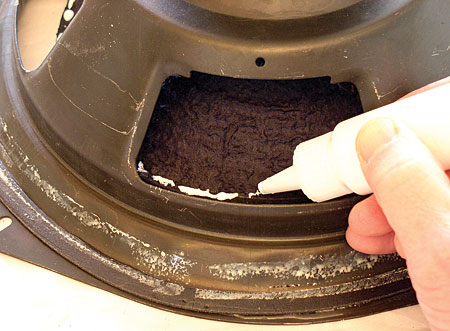
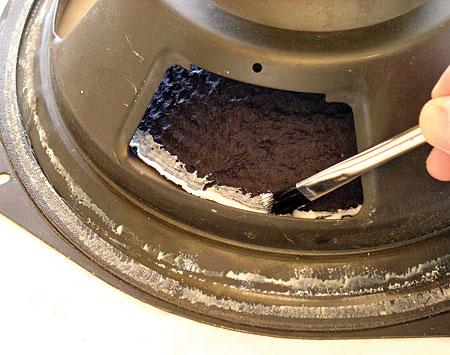
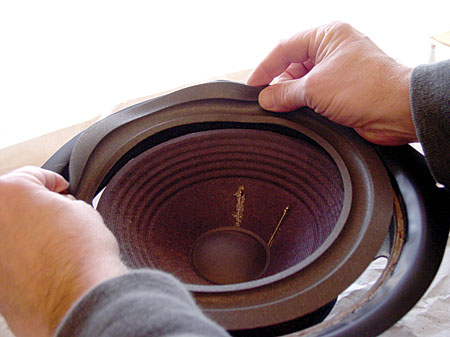
That's the route I went: I used test leads with alligator clips to connect each Advent woofer in turn to my amp, and drove the drivers with the 54Hz tone on Nordost's System Set-Up & Tuning Disc (CD, Nordost NOR TD-1) on continuous repeat. While the tone played, I glued the foam to the metal frame, then worked my way around the circumference, clamping them together with my fingers and listening for distortion whenever the surround and cone were pushed out of alignment—which took more effort than you might expect. (Countless Internet "experts" advise against operating a driver with a damaged or missing surround; while it's probably true that a driver mounted to an upright baffle must overcome gravity at the start of each distinct waveform, thus offering some slight opportunities for scraping before the coil and former center themselves, and while it's surely true that an intact surround is integral to the correct Q of the driver overall, such warnings seem to me a bit overstated.)
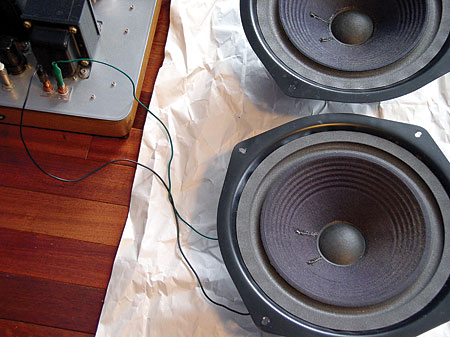
I waited another 24 hours for the glue to set: The newly repaired drivers were still in perfect alignment, as they are today. All that remained was for me to reinstall the woofers and do a bit of housekeeping.
More than a bit, actually: The last day of my project came during the sort of brief winter thaw that turns a middle-aged man's fancy not to love but to scouring and disinfection. I couldn't look at those stains a day longer, so I went to work with hot water, soap, and a good, stiff sponge. I was only partly successful, but at least the Advents now smelled of Murphy's Oil Soap instead of . . . well, never mind that.
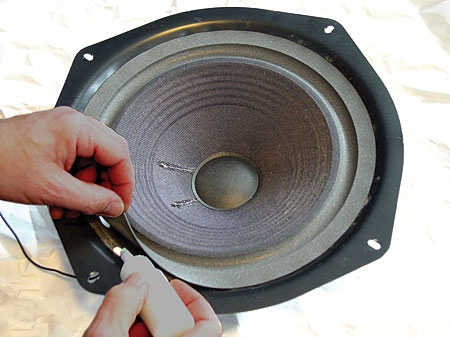
Unfortunately, my effort to clean the grilles was a complete failure. I carefully unstapled the light-colored fabric from the Advents' Masonite frames while filling the sink with cool water and Woolite, leaving the very thin, dark-colored backing cloth in place. But when I immersed the fabric in the water, the unhemmed edges began at once to unravel, and the stains remained, unfazed.
Sonics
Herb Reichert, who remains among my favorite audio writers of all time, once advised his readers not to kid themselves: Most things really do sound like whatever it is they're made of.
So it was with the Advents, whose papier-mâché woofers and stamped-paper tweeters—howsoever ingeniously shaped the latter may have been—were betrayed by a slightly dry, papery sound overall. With poorly recorded pop music they imparted a rasp to note attacks and transients, while cymbal crashes, applause, and other sounds characterized by sustained high-frequency tones were hashy. The Advents—which were also shockingly insensitive—really were more pleasant to listen to when tucked away amid piles of books and records, and in general weren't the sort of speakers I would select for nearfield listening. That's just as well, given their generally weak stereo imaging—no doubt a function of the thick frame around the baffle, and various other sharp-edged obstructions.
Bass notes, on the other hand, benefited from the Advents' good low-frequency extension and reasonably good speed. Instrumental and vocal timbres were right as rain. And somehow, the whole of the performance gelled and held together. Dry or not, raspy when pushed or not, the Advent Loudspeakers succeeded in getting the notes across. They played music better than they sounded—and, really, they didn't sound as bad as all my reviewspeak would suggest.
And my daughter loves them. In addition to sounding good, the Advents have a characteristic that appeals to her above all else: They are, indeed, hers. She likes that in a speaker.
In any event, where technology has progressed, value has just as surely shriveled up and died. Even taking inflation into account, the Advent Loudspeaker offered a lot of performance for just $116/pair in 1970 dollars—or $102, if you could get along without the walnut veneer.
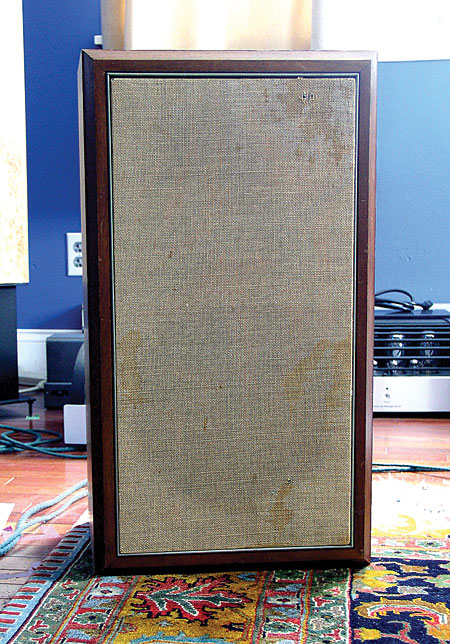
Don't just take my word or that of my daughter: Several years before he went west, where the finest and most expensive loudspeakers available would soon be passing through his hands, Gordon Holt took a different route and drove a pair of Advent Loudspeakers with his reference amp. Afterward, he declared in these pages, "After several weeks of listening, we still hadn't found anything to complain about. We couldn't even find any sonic characteristics to hang adjectives on, in order to try to describe their sound. They were, in fact, the least-colored loudspeakers we have ever heard, and this includes the highest-priced systems currently available." Gordon went on to praise the Advents' good dispersion and stereo imaging, and made a point of saying that the speakers didn't sound papery: observations that may well have been valid in the context of the audio market of the 1970s.
I can't think of a $500 or even $1000 pair of loudspeakers made today that matches the Advents' very agreeable performance overall—or offers a similar assurance that, in 2050, the poor, beat-up things could still be made to work. So it goes: Progress has given us much, but there will always remain certain qualities for which we can only stop, turn around, and go back.
Footnote 2: That is, round—an adjective that, sorry to say, can't be applied to certain high-efficiency full-range drivers.
- Log in or register to post comments




































